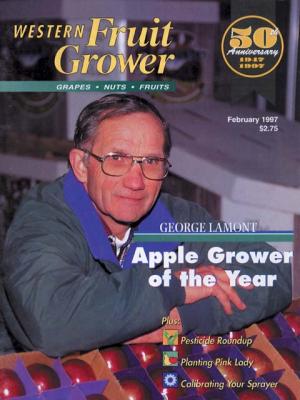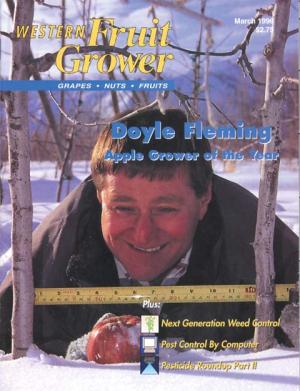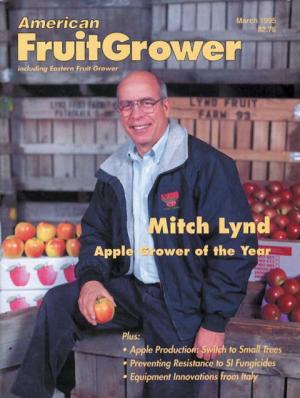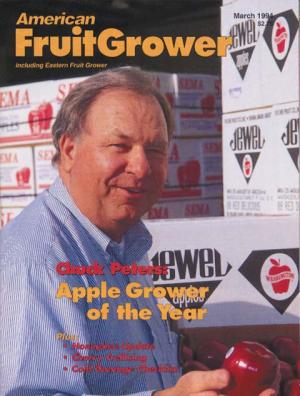Past Apple Growers of the Year Offer Marketing Tips And Tricks
Strategic marketing is an essential element to a successful operation, so, who better to ask about marketing approaches than past Apple Grower Of The Year winners? We caught up with each of them and asked “What makes you a successful marketer?”
Here’s what they said:
 2000: Brad Hollabaugh
2000: Brad Hollabaugh
Hollabaugh Bros., in Biglerville, PA, produces apples for their retail store, as well as the wholesale market. The operation consists of approximately 500 acres and is host to school tours and festival events.
One of the keys to successful marketing is having the right product, says Brad Hollabaugh.
“We have a few varieties that at one time were the right product and aren’t anymore. It doesn’t matter how glorious they are, if it’s not what the market wants, it’s not going to be successful,” he says. “The tricky part is identifying the right apple to plant for the market that’s coming.”
So how do you do that? Staying in touch and in tune with the industry and with the market. For example, his wife, Kay, is a member of the Board of Directors of the North American Farmers’ Direct Marketing Association. Hollabaugh stresses that it is also important to reach out to the community through school tours or festival events.
“It’s amazing how much follow- up business we generate by word of mouth (from these events).”
Bottom Line: Stay in touch and in tune with consumers by getting involved with them.
 1999 Ed Wittenbach
1999 Ed Wittenbach
Wittenbach Orchards, in Belding, MI, produces apples for the wholesale market and operates on 250 acres.
It is important to establish relationships with customers, according to Ed Wittenbach.
“We have some fairly strong accounts and those are the ones we try to match with the varieties we grow,” he says.
There are some agencies that are better at selling a particular variety than others and you have to focus on those agencies that are good at promoting your variety, he adds. Wittenbach works closely with his sales people, who in turn work closely with customers so that the varieties grown are the ones that are in demand by his customers. Although Wittenbach admits he has made a few mistakes along the way.
“We over-planted Empires, which have not moved in Michigan,” he says. “They just never got off the ground domestically — we took a gamble on it.”
Bottom Line: Communication is key. Know what consumers want and keep the lines of communication open with those you work with.
 1997: George Lamont
1997: George Lamont
Lamont Fruit Farm, in Albion, NY, produces apples for the fresh and processing markets, and operates on 60 acres. Being in close proximity to a city isn’t always an ideal situation for operating a farm market. George Lamont, whose farm is 30 miles west of Rochester, opened up a produce market, though it was not a successful venture for him. So instead, he strives to position his crop with the utmost quality in the marketplace.
“We are market-oriented and we produce to the highest value product in the wholesale market in terms of variety, in terms of size, and other factors of quality,” he says.
Bottom Line: Successful marketing doesn’t necessarily mean adding elements to your farm, like a market. Rather, enhance what you already have.

1996: Doyle Fleming
Wee Hoot Orchards, in Orondo, WA, produces apples for the wholesale market on 135 acres. The farm also includes a retail greenhouse operation.
When asked, “what makes you a successful marketer?,” Doyle Fleming’s answer is surprising.
“I have not been,” he says. “We have basically done the traditional thing for Washington growers, which is to deliver our product to the packer and they sold it to their marketer. That system, right now, is not working.”
So, last year, Fleming took his organic fruit (approximately 75 acres) and went to a smaller operation where it will be custom packed. He then found a marketer that he wanted to market his fruit.
“That seems to be working much better,” Fleming says.
He is also in the process of trying to form a variety co-op with about 100 other Cameo growers.
“We are attempting to change what we’ve done in the past to meet the changes of what’s occurring in the market,” he says.
Bottom Line: Sometimes it’s riskier NOT to change.

1995: Mitch Lynd
Lynd Fruit Farm, in Pataskala, OH, produces apples for the wholesale market, as well as a U-Pick operation, and is currently downsizing the orchards. Mitch Lynd believes that the fundamental problem with the wholesale apple industry is oversupply. In order to alleviate this problem for his operation, he is aggressively “bulldozing out thousands of trees,” and only keeping the parts that are economically sustainable. Lynd also runs a U-pick operation with “hot sellers like Honeycrisp, Goldrush, and Suncrisp.”
“With regards to our U-pick operation where we sell the ‘experience’ and the cost of admission is to buy a bag of apples, it is irrelevant how cheap a Chinaman can produce apples for or how thin a margin Walmart can operate on,” he says.
Bottom Line: Bigger is not necessarily better and growers must quickly adapt their operation to constantly changing demands.

1994 Chuck Peters
Peters Orchards, in Wapato, WA, produces apples for the fresh and processing markets, and operates on 350 acres.
“We just simply don’t grow fruit in the state of Washington particularly well for local consumption — we’ve got a pack and ship product so we’re more dependent on advertising and promotional programs than those who are closer to large urban populations,” says Chuck Peters.
Unfortunately, the state of the industry is forcing Peters to sell his operation at the end of the production season. In the past, he concentrated his marketing efforts on staying innovative in terms of production management and varieties.
“But with the capitalizing costs increasing and fruit returns decreasing, we’ve simply reduced our working capital to the point that we have to leave the business.”
Bottom Line: As the state of the apple industry continues to decline, be sure to evaluate your position carefully when making decisions about your operation.

1993 Roscoe Crist
Crist Bros. Orchards, in Walden, NY, produces apples for the fresh wholesale market on approximately 500 acres.
“I didn’t know there were any successful marketers out there at the moment,” Roscoe Crist laughs.
However, getting down to business, he says there are three things that he generally adheres to.
“Growing a good crop product, packing a good product, and being close to market,” he says.
He adds that although consumer demands change year after year, they always want a hard, good condition apple with flavor, and he is trying to meet that demand.
“We’re having to switch varieties that we grow,” he says, even though he admits that it can be difficult to figure out which ones are going to be in demand in the future.
Bottom Line: Varieties come and go, but the consumer will always want a quality product.










